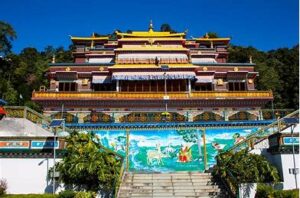Between the valleys and rivers of Manipur’s eastern hills, lies the cultural enclave of Chandel. It is more than just a district on a map, it is an unopened box of ancient history and traditions. This place speaks volumes through every aspect of its people’s lives. Chandel’s unique aspects built its rich cultural heritage.
Whispers of History
Chandel’s story combines the history of the ancient megaliths and chiefdoms. They thrived in these lands as warriors roamed with pride in the streets once. Tales of courage and valor echo in the names of villages like Lamshang, which translates into “sword point.” Tengnoupal is another such place where warriors used to rest in that era.
Each stone, each legend speaks of a proud heritage deeply intertwined with the land. The history of Chandel, Manipur can be roughly traced back to 490 BC, when the hilly Rajagriha was the capital of Ajatashatru. He was the king of Magadh, who wanted to move his capital to a more advantageous location to fight the Licchavis of Vaishali.
He selected and fortified the Ganges bank location. Only a few cities worldwide can match the city’s unbroken history since that time. When Gautam Buddha visited this location in the final year of his life, he foresaw both a prosperous future and the destruction of the area due to fire, flood, and feud.
Cultural Intermix of Tribes
Chandel is a salad bowl of tribal communities, each assimilating itself to the cultural fabric of this place. The Tangkhuls, the dominant group, practise their faith in traditional Morungs (community halls). Dances like the exhilarating Phailo (war dance) and the graceful Lui-Ngai (women’s dance) pulsate with life.
Thadous is known for its skilled craftsmanship. In their culture, weaving means more than a craft, it is describing the legends and they do it with a sense of duty. They weave old tales into their handloom creations.
The Meiteis, with their rich artistic legacy, add enthusiasm to festivals and ceremonies. Despite the different activities, there is a harmonious blend of tribal identities that creates a cultural landscape brimming with diversity and mutual respect.
Rhythms of the Land
Music and dance are the soul of Chandel. It pulsates through festivals, rituals, and their daily life. The rhythm of the Khongbom (bamboo flute) and the mournful melody of the Pena (string instrument) transcends their feelings into music.
The Phailo dance, with its mock sword fights and spirited footwork, celebrates the warrior spirit.
The Lui-Ngai, with its graceful movements and rhythmic steps, weaves tales of love and nature. Every beat and every step tells a story, preserving the cultural memory of the land.
Cuisine packed with Flavors
Chandel’s diet is a delicious mix of indigenous ingredients and age-old recipes. The aroma of smoked pork cooked in bamboo shoots fills the air, a testament to the close connection with the land.
Nganu is a spicy fish curry savoured by the locals. Other dishes like Khoureipak are made out of fermented bamboo which gives a unique earthy flavour. Every meal is served alongside freshly steamed rice and locally grown vegetables and herbs. The food reflects the bounty of the land.
Festivals
Festivals in Chandel are not just mere celebrations; they are vibrant threads intertwined into the fabric of community life.
The annual Lui-Ngai Tha (women’s festival) explodes in a riot of colours as women clad in traditional attire sing, dance, and share stories of their heritage.
The Yaoshang is the spring festival of colours. It unites people in laughter and joyous abandon. Each festival is a mirror image of Chandel culture which becomes a platform for sharing, celebrating, and strengthening the bonds that further bind the community together.
Nature’s Embrace
Chandel is blessed with breathtaking natural beauty. Lush hills rise majestically as cascading waterfalls fall through them. Rivers flow through the fertile valleys, beaming with life. This intimate connection with nature is reflected in every aspect of Chandel culture.
This district has erratic climate conditions. From subtropical climate to hot dry conditions called Moreh to very cold weather (Tengnoupal) during winters. Yet the locals accept it as their own and this never stops them from worshipping their land. They have songs that praise the mountains, and dances that mimic the movements of animals; the people of Chandel see them as an integral part of the web of life-sustaining in an ecosystem.
Beyond Borders
Chandel’s cultural influence extends beyond its geographical boundaries. Its rich folklore and storytelling traditions have captivated audiences across the region.
The Lai Haraoba dance of the Manipur valley has found a warm embrace in Chandel. They have improvised it using its artistic expressions. This cultural exchange adds to the lives of everyone involved. It showcases the unifying power of shared heritage and artistic expression.
Challenges faced by Chandel
Chandel has faced its share of challenges. The struggles of displacement and conflict have often caused disturbances in this land. Despite this, the locals’ resolve to preserve and strengthen its traditions has kept them together. To the inhabitants, it comes above all. This spirit is evident in the continued celebration of its festivals, adherence to age-old practices, and the yielding warmth of its people.
Conclusion
The people, the history, and the common connection that Chandel has with its land all contribute to its identity. Its cultural history is extensive. This site is braided together by the elements of art, tradition, nature, and heroic stories. It is a living, breathing entity that reflects history rather than merely a location.
Its colourful past, unique terrain, multicultural population, and close ties to the environment have sustained this gem in Manipur. Every part of Chandel reveals a deeper level of artistic expression, tradition, and a profound connection with the natural world. It showcases a blend of profound strength and enchanting beauty.
Today, Chandel is a reminder of its vivid past and a ray of optimism for the future. The heritage’s legacy keeps on existing despite time’s ever-evolving tides.
Unravelling a billion untold stories, one chapter at a time, Humans of Northeast takes you on a discovery through vibrant Northeast India – a land rich in people, places, and culture. Ready to immerse yourself in more such stories?
Visit our page HONEI to read more about narratives that inspire and uplift.




